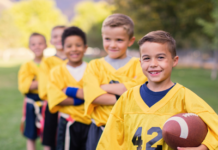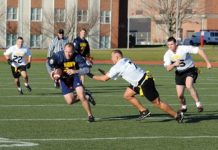
Football is determined by its great involvement of players and sport spirit. Sometimes, the players either intentionally or unintentionally cause damage to other players or defy the game rules that are named fouls.
As something must be imposed for the sake of fairness of the game, so penalties are introduced in order to decline the number of fouls, and if they occur, there is something that will bring clarity to the game.
Football penalties are judged by a crew of six members/officials that are called referees. The referees wear clear stripped white and black shirts, black and white pants, and white ball caps. There is a head referee among them who wears a black ball cap.
These officials own a whistle that gives them the power to stop the game anytime by blowing it in the required style. The head official owns a stopwatch that helps him to take care of the official game time.
How penalties are determined?
Each of the officials is given a yellow flag which he must throw when he determines a foul to indicate a penalty. The officials are also provided with bean bags which they can throw at the second penalty.
Officials usually throw the bean bags to identify and mark the exact(predicted) location where the foul was made to maintain the measurement.
Penalty yardage
Especially in American football, penalties are given by marking off yardage(some yards). The yardage differs between five to fifteen yards per penalty according to the intensity of the foul.
Less harmful or intense fouls are given a five-yard penalty.
Moderate or intermediate fouls that seem to violate the game rules are enforced a ten-yard penalty.
Whereas,
Fouls that are considered very intense and could cause harm to other players are taken as violating the game spirit and are given a fifteen-yard penalty.
Some special Yardage penalties
Apart from these five to fifteen yards yardage penalties, some other yardage penalties are enforced in special circumstances.
We have mentioned the other yardage penalties in a brief below.
Interference
In simple words, we can call it a non-contact with the ball foul. Sometimes, to prevent an attack or to cut the defense, the player intentionally makes contact(often heavy contacts) with the other player before he gets the ball.
Also Read: Basic Skills – Flag Football Drills for Kids
This could happen even after five yards of the scrimmage line, to avoid the player from getting the ball.
Interference fouls can either be considered offensive or defensive. However, defensive fouls are more often.
Circumstances to Avoid interferences
Not every time does the referee call out for a penalty. There are some situations where players can make contacts without interference being called out.
If the ball traveling seems to be uncatchable to the player, then the referee does not call for any interference even if contact was made.
Players are also allowed to make contact when the defender tips the ball on its flight to the receiver.
Sometimes two players collide with each other and their legs get tangled. In such cases, there is a rule named ‘incidental contact’ according to which neither of the players can blame the other for the entanglement. The referees can not call for a penalty in such cases.
In National Football Leagues, Interference penalties are given from the spot of foul or contact. This is done to recover the potentially lost yardage of a long pass play by covering about 40-50 yards.
In college football leagues, the interference penalties are always worth 5 yards. This gives a great benefit to the defenders who can easily tackle their opponent that seems to be unstoppable by executing a foul and taking a five-yard penalty instead of giving him a touchdown.
Half distance penalty
In many football leagues, a team is penalized near their goal line where the penalty yardage is a bit far than half of the goal line, the penalty yardage is assessed to the goal line i.e half the distance.
As per this rule, if a player commits a foul worth a five-yard penalty which is offered at 4 yards, then the referee will call assess it to 2 yards(half the distance of yardage).
In some games, these penalties play the role of the automatic first down.
Out of boundary kickoffs
When the team starting the kickoff kicks the ball out of the boundary, they are fined a penalty at the opponent’s 40-yard line automatically.
Intentionally grounding
Sometimes, the defender or say the quarterback attempts a foul on the player to get the ball to avoid a sack. The referee immediately plays the whistle considering it a dead play and the team is fined a penalty at the spot of the foul.
The penalized team also loses that quarterback due to the red card.
Other fouls or penalties
There is a big list of rules and terms of a football game, we have listed down some of the common and often viewed fouls or penalties.
False start
A false start is usually considered when an attacking player sets up for a move or snap before the ball is snapped. We know this by the term ‘offside’ and a five-yard penalty is provided to the opposition.
Illegal procedures
An Illegal procedure is called when an offensive player or a forward player moves before the snap of the ball without setting properly or he is running perpendicular to the line of scrimmage when the ball is snapped.
The rule is that the forward skilled players can move parallel to the line of scrimmage before the ball is snapped and one of them can run perpendicular to that line before the opposition snapping the ball. The players ought to set for a second before the ball snaps.
Violating these rules leads to a five-yard penalty.
Holding
In simple words, Preventing the other player from catching the ball is termed ‘Holding’.
In brief, if a defensive holds the jersey of the opponent’s offensive player, grabs his arms, or wraps his arms around the offender, then a defensive holding is called and a five-yard penalty is assessed. This is also the first down of the offensive team.
Similarly, if an offensive player holds the jersey of the opponent defender, or grabs his shoulders, it is called an offensive holding, and a ten-yard penalty is given to the opposition.
Encroachment
An Encroachment penalty is usually called if a defensive player gets across the line of scrimmage and does not return to the field before the snap.
Also, If the defensive player crosses the line of scrimmage forcing a set offensive player to move, an encroachment is called off by the referee.
Encroachment leads to a five-yard penalty to the defense, along with a replay of the down.
The offense has the right to decline the penalty if their move of the play is more advantageous.
Chop blocking
If a defender is running on a block and leading to a successful block, then if an offensive player is engaged with the defender in a block and another offender is engaged holding the waist of the defender, this is called ‘chop blocking’.
A chop block is considered a dirty play in the game where the defender can complain against the offender for attempting intentionally knee damage. Chop blocking has led to several conflicts between teams.
A fifteen-yard penalty is executed again chop blocking.
Illegal back blocking
If a defender is successfully holding the ball and the offensive player blocks him from behind, an illegal back blocking is called out.
Also Read: Flag Football Games for Kids
Similarly, if a defender is blocked by an offensive player behind the front shoulder pads, an Illegal back blocking is called out.
Regarding this foul, A ten-yard penalty is assessed by marking a gray area with the blocks.
Game Delay
In National leagues or professional games, there is a 45 seconds timing between plays. If the offensive players do not snap the ball before the timing(before the 45 seconds are up), a game delay penalty is assessed.
A five-yard penalty is assessed by the referee.
Face Mask
When an offensive player grabs the face of the defender or vice versa, a face mask foul is assessed with a five-yard penalty.
However, In some cases when a player grabs the face of the other player for a tackle or manhandle attempt, it is a serious foul, and a fifteen-yard penalty is assessed by the referee.
Illegal celebration
Illegal celebration has been a common and frequent issue throughout the years.
If a player scores a goal(touchdown), he is not allowed to involve other team members in a choreographed celebration, to use some items or props for his celebration, or fall to the ground while celebrating the touchdown.
The team members are also not allowed to leave their bench area to join the celebration, too. If any of these things happen, it is called an illegal celebration and an un-sportsmanship spirit appears.
For this, a fifteen-yard penalty is assessed on the following kickoff.
Conclusion
Football penalties have played a key role in maintaining the game spirit and fair play. Over the years, penalties have extended their field and are distributed over hundreds of small divisions.
For a football penalty, a crew of referees is formed with an official uniform with some powers
.
A yardage penalty is assessed for any foul and it differs from five to fifteen yards.








